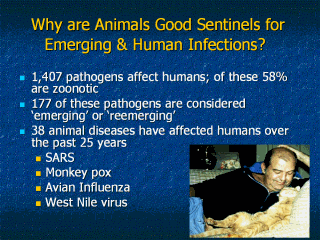| front |1 |2 |3 |4 |5 |6 |7 |8 |9 |10 |11 |12 |13 |14 |15 |16 |17 |18 |19 |20 |21 |22 |23 |24 |25 |26 |27 |28 |29 |30 |31 |32 |33 |review |
 |
∑ The SARS, monkey
pox, West Nile Virus, and avian influenza outbreaks brought to light that
the biological agents causing most human emerging diseases have as their
normal reservoir animals including food-animals, wild animals, and companion
animals. ∑ A zoonotic disease is one that is naturally transmissible from animals to people. ∑ Zoonotic diseases occur where people live in close proximity with food animals such as poultry in developing countries (avian influenza), consume wild animals such as Civet cats (SARS), own exotic pets such as prairie dogs (monkey pox), or simply covet dogs and cats as pets (toxocariasis) ∑ It is the veterinarianís responsibility to identify zoonotic diseases in their patients before they can spread to humans |